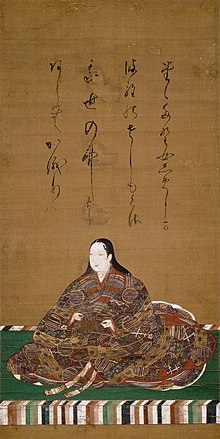
Back Yodo-dono BCL Jodo-dono Czech Yodogimi Spanish یودو دونو Persian Yodo-dono French Yodogimi Italian 淀殿 Japanese 요도도노 Korean Yodo-dono Portuguese Госпожа Ёдо Russian
Yodo-dono 淀殿 | |
|---|---|
 Yodo-dono | |
| Personal details | |
| Born | Chacha (茶々) 1569 |
| Died | 4 June 1615 (aged 47–48) Osaka Castle |
| Nationality | Japanese |
| Spouse | Toyotomi Hideyoshi |
| Children | Toyotomi Tsurumatsu Toyotomi Hideyori |
| Parents |
|
| Relatives | Ohatsu (sister) Oeyo (sister) Oda Nobunaga (uncle) Kyōgoku Maria (aunt) Shibata Katsuie (step-father) Nene (adopted mother) Ōno Harunaga (foster brother) |
| Military service | |
| Allegiance | |
| Battles/wars | Siege of Osaka |
Yodo-dono (淀殿) or Yodogimi (淀君) (1569 – June 4, 1615), also known as Lady Chacha (茶々), was a Japanese historical figure in the late Sengoku period. She was the concubine and the second wife of Japanese ruler Toyotomi Hideyoshi. As the mother of his son and successor Hideyori, she acted as Hideyori's guardian in the restoration of the Toyotomi clan after the fall of the Council of Five Elders, and alongside her son, led the last anti-Tokugawa shogunate resistance in the siege of Osaka.
She was the daughter of Oichi and sister of Ohatsu and Oeyo. When her two younger sisters became prominent members linked to the Tokugawa clan, Oichi's three daughters were vital to maintaining a diplomatic relationship between the two most powerful clans of the time, Toyotomi and Tokugawa. Her sister, Oeyo, was the wife of the second shogun, Tokugawa Hidetada, and matriarch of the successive shoguns' lineage, thus receiving the political title Omidaidokoro.
Due to the attempt to exalt the Tokugawa Shogunate, Yodo-dono was frequently portrayed as a "wicked and wanton" woman who planned the Toyotomis' death. After the death of Hideyoshi in 1598, she took the tonsure, becoming a Buddhist nun and taking the name Daikōin (大広院). She was the founder of the temple Yogen-in (養源院).
Her time period being that of large turmoil and overhaul, Yodo-dono had an interest toward both politics and administration. The great wealth and changing fortunes of her family affected Yodo-dono's life as well. Surviving record books from luxury goods merchants provide insight into patterns of patronage and taste amongst the privileged class of women like Yodo-dono and her sisters.[1]
- ^ Hickman, Money L. et al. (2002). Japan's Golden Age: Momoyama, p. 283.
© MMXXIII Rich X Search. We shall prevail. All rights reserved. Rich X Search